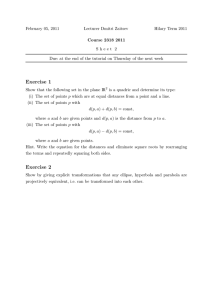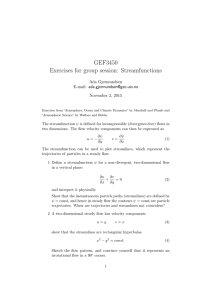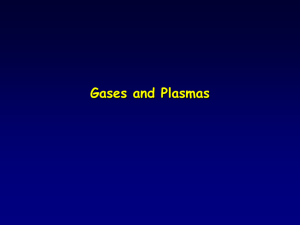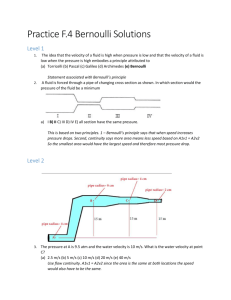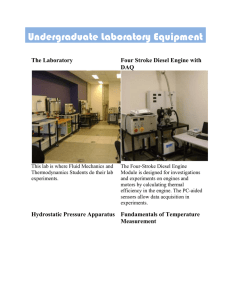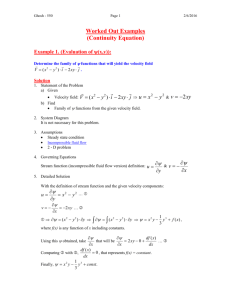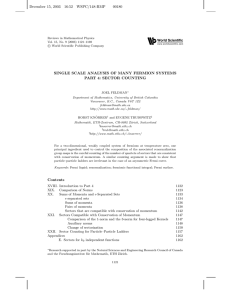V h A +
advertisement
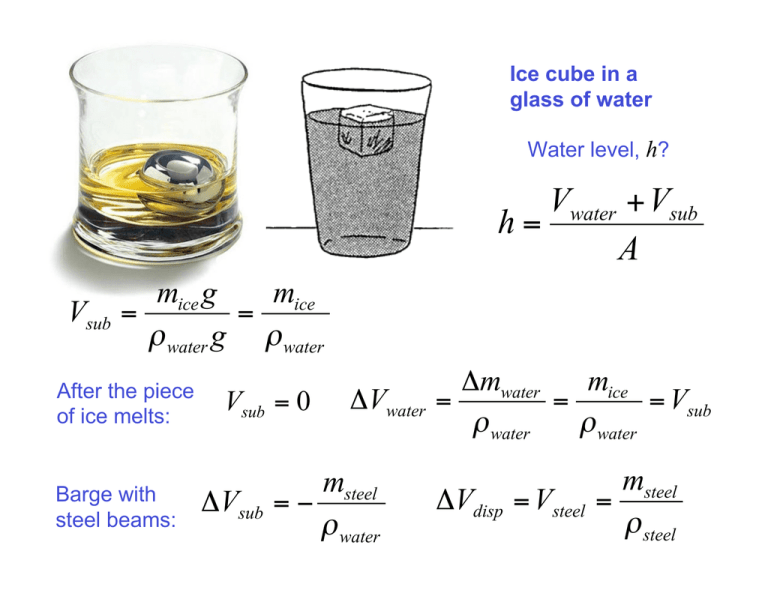
Ice cube in a glass of water Water level, h? Vwater + Vsub h= A Vsub mice g mice = = ! water g ! water After the piece of ice melts: Barge with steel beams: Vsub = 0 #Vsub !Vwater msteel =" ! water !mwater mice = = = Vsub " water " water "Vdisp = Vsteel msteel = ! steel Steady flow in a river. Velocity in each point is shown by a vector with the length proportional to the velocity. Velocity gets higher, where the river gets narrower. Flow represented by streamlines, that are everywhere tangent to flow direction. Higher density of the streamlines corresponds to higher flow velocity. In a steady flow there are no variations in velocity and pattern of flow in time. Nevertheless, the actual fluid elements flowing past any particular point at different times are always different. The fluid elements also get accelerated and decelerated as they move along the streamlines. Motion of fluids obeys the standard laws of mechanics. Newton’s second law: r r F = ma Becomes Navier-Stokes equation: Newton’s second law is actually a complicated differential equation! r r d r F =m 2 dt Any way to make our life easier?! Let’s try to use the laws of conservation!! 2 Motion of fluids obeys the standard laws of mechanics. m = const r r Conservation of momentum: mv1 + mv2 = const Conservation of mass: Conservation of energy: 2 mv KE + PE = + mgh = const 2 Using the laws of conservation means doing appropriate bookkeeping and doing algebra instead of solving differential equations! Steady flow Flow tube A small tubelike region bounded on its sides by a continuous set of streamlines and on its ends by small areas at right angles to the streamlines. Cross-section areas on the left and right ends are: A1 and A2. Densities and velocities are: ρ1, ρ2 and v1, v2 Mass of fluid entering the tube from the left over the time interval Δt !x1 = v1!t Steady flow !V1 = A1v1!t m = "1!V1 = "1 A1v1!t By mass conservation, over the time interval Δt, the same mass is exiting the tube from the right m = " 2 A2 v2 !t Therefore "1 A1v1!t = " 2 A2 v2 !t !1 A1v1 = ! 2 A2 v2 !vA = const everywhere along a flow tube If the fluid is incompressible and its density, ρ, is constant, we have vA = const vA = const Does it work for traffic? Once you pass the spot of accident there are more lanes available (larger A) and the traffic speeds up (higher v). What is the matter? Traffic is highly compressible. You have got to use !vA = const How does the total energy of a small fluid element change, as it moves inside the flow tube from cross-section 1 to cross-section 2? Kinetic energy: 1 "KE = m(v22 ! v12 ) 2 Potential energy: "PE = mg (h2 ! h1 ) How does this change in the total energy become possible? There are external forces originating from pressure of the liquid outside the tube, which do work on the fluid element! Positive work as it enters from the left Negative work as it exits from the right The total energy balance W1 = F1!x1 = P1 A1!x1 W2 = F2 !x2 = " P2 A2 !x2 !KE + !PE = W1 + W2 1 2 2 m(v2 " v1 ) + mg ( h2 " h1 ) = P1 A1!x1 " P2 A2 !x2 2 The total energy balance 1 2 2 m(v2 " v1 ) + mg ( h2 " h1 ) = P1 A1!x1 " P2 A2 !x2 2 V Incompressible fluids – constant density and volume V = A !x = A !x 1 1 2 2 1 2 1 2 P1 + !v1 + !gh1 = P2 + !v2 + !gh2 2 2 1 2 P + !v + !gh = const 2 Bernoulli’s equation Bernoulli’s equation 1 2 P + !v + !gh = const 2 Inertial jet The fire truck pump is generating a pressure P. What is the maximal velocity at the nozzle? What is the maximal height the jet can reach? Venturi Flowmeter The venturi flowmeter is a practical instrument which makes use of the Bernoulli effect and a manometer pressure gauge.
